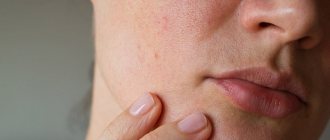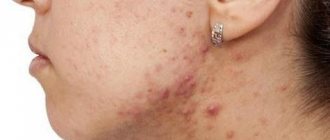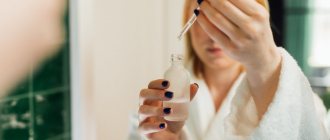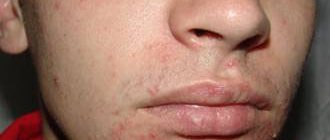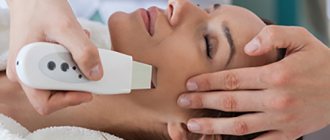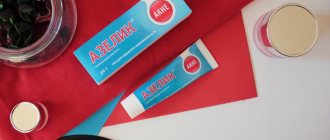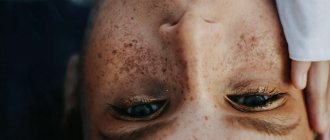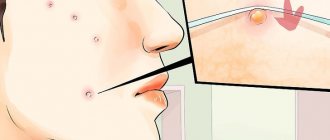Causes of subcutaneous acne
In order to eliminate this problem, it is necessary to know exactly its root cause, which provoked the appearance of subcutaneous acne on the face. Only then will it be possible to apply a full range of measures aimed at getting rid of this problem.
If you use only cosmetics for this, which temporarily remove only the visual manifestation, the result can be serious complications.
The reason for their appearance is primarily due to such malfunctions in the sebaceous glands:
- violation of sebum secretion;
- clogged sebaceous ducts;
- the occurrence of an inflammatory process in the sebaceous glands;
- active activity of skin bacteria and, as a result, the formation of painful and unsightly subcutaneous pimples;
- problems with the stomach and intestines;
- accelerated hair follicle growth;
- disturbances in the functioning of the endocrine system.
1.General information
Erysipelas, erysipelas - these and similar terms are used mainly in Slavic languages; in medical Latin and most Western European languages, the original ancient Greek name erysipelas was fixed, i.e. "red skin" In the old days there were also synonyms “holy fire”, “Saint Anthony’s fire” or, in Russian, “Antonov’s fire”, although some dictionaries define this term as one of the designations for gangrene.
Erysipelas is an acute skin infection (or recurrent exacerbation of a chronic one), the hallmarks of which are swelling and erythema - a bright red, “fiery” hue of the affected area. In general, erysipelas is one of the most common human infectious diseases; the localization of inflammation can be very different, however, due to the peculiarities of the anatomical structure, the disease often manifests itself on the skin of the face, primarily in the soft tissues of the external nose (vestibule, wings, nasal walls): a high concentration of sebaceous glands, capillaries and nerve endings facilitates the penetration and activation of the pathogen .
A must read! Help with treatment and hospitalization!
What do large subcutaneous pimples look like?
Subcutaneous acne is a problem that can affect anyone, regardless of their age. When they appear under the epidermis, a dense small ball is felt, and later, during maturation, a white, yellow or red bump appears on the skin. If you press on it, the person feels pain. The inflammatory focus can be located anywhere on the face: on the cheeks, chin, nose and forehead.
There are the following types of subcutaneous acne:
- subcutaneous red pimples are inflamed areas, the size of which increases over time;
- white subcutaneous pimples - a cavity filled with pus. It can be preserved without changing its appearance for a long time.
The initial size of red pimples is from one to two millimeters. While the inflammatory process develops, a purulent cavity appears inside the skin, resembling a white or yellow tubercle in appearance. Since these pustules are located under the skin, getting rid of them is quite problematic.
Photo
Rhinophyma (inflammation of the skin of the nose)
is an inflammation of the skin of the nose due to the proliferation of connective tissue, blood vessels and sebaceous glands, which leads to disfigurement of the nose (wine nose, pineal nose). It can occur as a benign tumor formation.
Symptoms of rhinophyma
The disease develops gradually - it begins with itching, flaking and slight redness of the skin of the nose. Then tubercles form, the skin thickens, soreness, a bluish color, spider veins appear, the nose loses its normal shape, grows, becomes disfigured, and the resulting formations can interfere with breathing, reducing the quality of life.
Have you noticed the following symptoms? Make an appointment
Forms of the disease
Rhinophyma is distinguished by the form of manifestation of the disease:
- in the fibrous-angiomatous form, the size of the nose is uniformly increased, the color of the nose is copper-red or purplish-red, veins are clearly visible, small cavities with blood-purulent contents are observed, which subsequently turn into crusts.
- with the granular (glandular) form, cluster-shaped formations on the nose of a bluish-red color are observed, which close the nostrils and mouth, disfigure the person’s face, and make breathing and eating difficult.
- with the fibrous form of rhinophyma, a finely lumpy appearance of the nose is noted, while the skin is smooth and bluish-violet.
- with the actinic form of rhinophyma, a uniform enlargement of the nose occurs with the expansion of spider veins and capillaries on the wings of the nose.
Causes of the disease
Rhinophyma may be caused by demodex, a microscopic skin mite. In addition, the causes may be skin diseases that are inflammatory and chronic in nature, such as rosacea and acne.
The development of the disease is facilitated by hypothermia or prolonged exposure to the sun, alcohol abuse, chronic diseases of the gastrointestinal tract and endocrine system, and autoimmune diseases.
Diagnostics
Diagnosis is based on an examination by an ENT doctor, a dermatologist and sometimes an oncologist. In some cases, a biopsy is indicated to exclude a malignant process. The specialist identifies the cause of rhinophyma, takes a scraping for demodex, and, if necessary, examines hormonal levels and the gastrointestinal tract. General blood tests, biochemical tests, as well as for the presence of parasites and infections are taken.
We recommend that you consult a doctor! 276-00-15
Treatment of rhinophyma
Treatment is aimed at eliminating the aesthetic problem and restoring normal nasal function. In the initial stages, local hormone therapy, drugs that improve blood microcirculation, drugs that improve digestive function are used, and if necessary, hormonal levels are adjusted.
As the disease progresses, surgical treatment using surgical laser and radio wave surgery is used. Under local anesthesia or endotracheal anesthesia, hypertrophied areas of skin are removed, creating a wound surface that is covered with a skin scab after 10-12 days. After the surface is cleansed, the skin looks reddened, but over time it acquires its normal color.
doctor
In more advanced cases, plastic surgery is performed with wedge-shaped excision of the affected connective tissue, tissue transplantation and suturing.
Typical location
Let's look at the most typical places where large subcutaneous pimples appear.
All over the face
Based on the location of subcutaneous acne, you can determine in which organ the problem exists:
- Forehead. Intestinal diseases. Changes in normal microflora occur due to prolonged stressful situations, depression or weakening of the body as a whole. These problems may well serve as an impetus for the appearance of colitis or dysbacteriosis.
- Near the eyes. The skin around the eyes is an area whose condition is affected by the functioning of the kidneys. Subcutaneous pimples here signal a malfunction in their functioning. In addition to acne, edema may also appear, that is, accumulation of fluid that is not removed from the human body by the kidneys.
- The inner side of the eyelids. A visit to the ophthalmologist is a must. Pimples on the inside can appear for a number of reasons, so you should not ignore this problem.
- Cheeks. The stomach, liver and intestines do not work well, and, therefore, toxins that accumulate in the gland ducts are practically not removed from the body. Purulent inflammation of the skin occurs. The cause of such acne can also be an incorrect diet, consumption of fatty and salty foods.
- In the mouth. A symptom of the onset of stomatitis or candidiasis, the cause is a weakened immune system.
- From the inside on the lips. Visit an ENT specialist or dentist, there are many reasons: from an allergic reaction to ulcerative stomatitis.
- Chin. A subcutaneous pimple on a woman’s chin can be a sign of diseases of the reproductive organs. Hormonal imbalances provoke their appearance.
- Between the nose and mouth. Problems with the cardiovascular system.
Another disease with the formation of pustules, demodicosis, has similar symptoms. You can read detailed information about the disease and treatment of demodicosis on the face here.
On the nose
Causes of subcutaneous acne on the nose:
- Hormonal disbalance. The main reason for the appearance of almost any acne. If subcutaneous acne appears in a person who has never had such skin problems, then we are most likely talking about hormonal imbalances. If they occur extremely rarely at all, but are now localized specifically on the nose, this is exactly the problem. The cause could be anything: stress, menstruation, and so on. Most often, such a failure does not last too long and the skin is restored. Dealing with hormones is difficult, especially for teenagers. If the situation does not improve, but only gets worse, it is best to consult a specialist. Hormonal imbalance can also lead to the appearance of red moles. In another article, we discussed the reasons for the appearance of red moles on the body in women.
- Problems with the digestive system. Eating the wrong foods or diseases of the internal organs, for example, ulcers. The stool should be normal.
- Clogged pores on the nose. The nose is the place where the pores are closest to the surface of the skin, which is why comedones often appear on it. The best option to get rid of the problem is mechanical facial cleansing performed by a cosmetologist.
Causes of acne in adults
11.11.2021
Acne is most often associated with a problem among teenagers. Probably, most of us in adolescence struggled with acne on the face , appearing unexpectedly and at the most inopportune moment. Acne is associated with major hormonal changes that occur in our body during this turbulent period. Teenage acne can be more or less persistent, the skin is usually oily, seborrheic, and pimples most often appear on the forehead, nose and chin, that is, in the so-called T-zone. What to do when you approach 30, even 40 years old, puberty and hormonal storm are already behind you, but the problem persists? Such ugly skin lesions deprive us of self-confidence, cause many complexes, reduce self-esteem, and cause disappointment, which affects our professional and personal lives.
Causes of acne in adults
This problem affects women more (approximately 12%) than men (up to 3%). Contrary to popular theories that hormones , they are less important in this case. Yes, these are not rare cases when women struggle with endocrine disruptions. This happens, for example, when we stop taking birth control pills. Acne medications :
- Creams, ointments, supplements
- Cleansing patches
- Spot treatments
- Day creams, night creams
- Facial gels , peelings
- Masks, tonics
A consultation with a gynecologist or endocrinologist will be required to determine the level of hormones at different levels (sex and thyroid hormones , hypothalamus, pituitary gland , adrenal glands) to eliminate deeper health problems.
The main reason is a busy lifestyle and stress, which stimulates the adrenal cortex to produce cortisol. An unhealthy diet , rich in highly processed foods and a high glycemic index, increases the production of androgens due to rapid spikes in insulin, which also causes increased seborrhea . Very often, acne is also a symptom of lactose intolerance, found in milk and dairy products. Working indoors with air conditioning, environmental pollution, smoking, and improper care, unfortunately, only work to the detriment of our skin.
How is acne in adults different from acne in teenagers?
- skin lesions are located elsewhere, i.e. most often in the lower face , around the jaw, mouth , chin and neck
- They are not as intense, but last a long time, leaving permanent scars, discoloration and unevenness on the skin.
- the skin, despite the increased production of sebum, tends to dry out
- hyperkeratosis occurs at the mouth of the hair follicles, where anaerobic bacteria begin to multiply
How to cure acne in adults?
Unfortunately, treating acne in adults is very complex, time-consuming and requires a lot of systematic work. acne care does not bring the desired results and even increases dry skin, such a person sooner or later turns to a dermatologist . The most commonly used antibiotics are antibiotics (tetracycline, doxycycline) and retinoids. The former are very often effective only during treatment, and after its completion, skin problems return. However, problems may arise due to dysregulation of the bacterial flora of the gastrointestinal tract.
The effectiveness of isotretinoin, on the other hand, is much greater, but treatment with it is not the most pleasant and requires greater sacrifice. Isotretinoin is a derivative of vitamin A, a more aggressive form, and its exact mechanism of action is not fully understood. It regulates the processes of differentiation of epidermal cells, inhibits the activity of glands, which reduces the production of sebum. During the first stage of treatment, when the skin is cleared, its condition may deteriorate sharply, but the subsequent effects are impressive. The minimum treatment period is 5-6 months under strict medical supervision. Unfortunately, the side effects of isotretinoin are very unpleasant and problematic, and the list is long, such as excessively dry skin, liver , hair loss, and even depression .
Locally, for lesions on the face , gels or creams with antibiotics (erythromycin, clindamycin), with benzoyl peroxide, which acts on anaerobic bacteria, with retinoids, azelaic acid, adapalene with keratolytic, anti-inflammatory and anti-acne properties are prescribed. Caring for such problematic skin and the correct selection of cosmetics are of great importance. The skin should be thoroughly cleansed with mild water-based preparations (avoid milk), moisturized with non-comedogenic creams rich in plant extracts, vitamins C and E, retinol (its milder forms, for example, retinaldehyde), and delicate peels should be performed, preferably based on glycolic or salicylic acid. acid.
It is also recommended to take B vitamins, especially vitamin PP (niacin), biotin, vitamins E, C and trace minerals such as zinc, selenium and copper. The beneficial properties of pansies for skin conditions have also been known for centuries . Let's not forget to change our diet to more fresh fruits and vegetables, limit highly processed foods, fast food full of unhealthy fats, sweets and salt.
Published in Dermatology Premium Clinic
What to do with large subcutaneous pimples?
There are conservative and modern methods of combating subcutaneous acne. Traditional medicine also comes to the rescue.
How to speed up the maturation of a pimple?
It is possible to eliminate a subcutaneous pimple without harm to the skin only when it is fully mature. This is preceded by a period of redness and the appearance of purulent growths. The inflammatory process that develops inside the lump lasts a week or more.
You might be interested! Chiria: what is it and how to get rid of them using folk remedies?
Using an anti-inflammatory agent will help make the pimple ripen faster, for example:
- Vishnevsky ointment;
- levomekol (antibiotic);
- ichthyol ointment.
The same ointments are used to ripen boils, which can be confused with large subcutaneous pimples. In another article you can visually evaluate a photo of a boil.
The above remedies are a set of drugs, the effects of which will eliminate inflammation and pain, minimizing the spread of infection. These methods are best used if a subcutaneous pimple has appeared on the forehead, chin, lips or other places. Squeezing and other methods of self-treatment will lead to unpleasant complications.
2. Reasons
Erysipelas is a bacterial infection, the causative agent of which is almost always group A beta-hemolytic streptococci. This tendency, however, is not absolute: a similar inflammation can be caused by staphylococcus, especially in cases of a long-term chronically recurrent process, as well as other pathogens. In general, we have to take into account the fact that in recent decades in the clinic of infectious diseases, incl. skin, there is a steady tendency towards an increase in combined invasions (for example, bacterial and fungal), developing according to the mechanism of super- or coinfection.
The main risk factor is microtraumatization of the skin of the nose in combination with weakened local immunity and non-compliance with sanitary and hygienic rules.
The risk increases in the presence of foci of chronic coccal infection in adjacent tissues and organs (otitis, tonsillitis, sinusitis, and many others). One of the widespread causes of erysipelas is the practice of self-squeezing out elements of acne and/or pustular (pustular) rash in unsterile or frankly unsanitary conditions. In some cases, nasal erysipelas is iatrogenic in nature, i.e. the launch of the pathological process is caused by medical procedures or surgical intervention on the ENT organs.
Visit our Otolaryngology (ENT) page
Modern methods of treatment
In order not only to remove the pimple itself, but also to get rid of the cause of its occurrence forever, the best option would be to contact a qualified specialist. After a thorough examination, he will accurately determine the cause of the growth and select the appropriate treatment method for you.
Ozone therapy
A subcutaneous pimple is a very painful formation, however, it can be removed with the help of ordinary oxygen. Modern medicine often offers ozone therapy for this, which has a simple but positive effect.
Effect of ozone therapy:
- Even the most severe pain goes away;
- Ozone is a type of oxygen that effectively fights microbes;
- Redness and swelling are eliminated;
- The production of keratin and elastin is restored;
- You don't have to worry about acne marks (red spots, scars).
The procedure is carried out as follows:
- Introduction of collagen-ozone composition into the inflamed area.
- Thus, several injections are given, depending on the amount of inflammation.
The procedure takes no more than half an hour.
Elos method
The most effective and safest way to get rid of subcutaneous internal acne. During the procedure, blue rays are applied directly to the inflammation.
Result of the procedure:
- intensive renewal of skin cells;
- eliminating redness, bumps, growths or scars left after a pimple matures;
- reduction of pores due to a decrease in the amount of sebum penetration into them;
- absence of peeling, irritation and dryness of the facial skin.
3. Symptoms and diagnosis
As shown above, typical manifestations of erysipelas of the nose include erythema and inflammatory swelling of the soft tissues, clearly demarcated by a roller from healthy skin. The swelling can be so severe that the patient’s face becomes deformed and changes beyond recognition. Blisters filled with mucopurulent exudate (bullous form of erysipelas) are often observed.
As a rule, the general symptoms of infectious intoxication are pronounced: malaise, fever, hyperthermia (up to 40° and above), headache, weakness, soreness and swelling of the nearest lymph nodes. After a few days, body temperature may drop just as sharply.
It should be noted that in the absence of timely adequate therapy, erysipelas tends to expand to neighboring areas (skin of the face, neck, chest, ear, etc.); with the involvement of the mucous membranes and submucosal layers of the pharyngeal structures, the development of such serious complications as abscess formation, phlegmon, sepsis, and intracranial inflammation is possible.
The clinical picture of erysipelas is quite specific and usually does not create any difficulties in diagnosis. Examination of the ENT organs reveals hyperemia of the mucous membranes of the nasal cavity. Laboratory diagnostic methods are used to identify the pathogen(s) and assess drug sensitivity. In more complex cases, they resort to instrumental imaging diagnostics (endoscopy, ultrasound, etc.).
About our clinic Chistye Prudy metro station Medintercom page!
ethnoscience
Sometimes you can get rid of subcutaneous acne at home.
The following methods are relevant here:
- Aloe. As soon as you notice that you will soon have a subcutaneous pimple, immediately begin treatment. Compresses with aloe will be useful - its leaf is washed, divided into two parts, after which one of the parts is applied to the pimple with its pulp.
- Nettle decoction. An excellent anti-inflammatory agent. It should be used for about one month. It will help normalize metabolism, which will help remove toxins from the body, which means the skin will become clear very quickly.
- Do not wear clothes made from synthetic material.
- Wipe your face with a special lotion about three times a day. You can prepare it yourself: just mix boiled water and fresh lemon juice.
- Tea tree essential oil will help effectively get rid of any acne on the face. It should be applied to inflamed areas several times a day. This method will not only help eliminate inflammation, but will also dry out the skin.
- An excellent method is salt cleansing. Take a cotton swab, soak it in alcohol, and then dip it in a mixture of salt and baking soda. Apply to the pimple. After a few minutes, wash your face.
- Sometimes use this mask: mix butter, onion and honey, everything is taken in equal proportions. Bring the mixture to a boil, then allow to cool. At the end, mix it with a small amount of flour, form a cake and apply it to the site of inflammation.
- Crush ten tablets of trichopolum and two tablets of chloramphenicol Apply the solution to a cotton swab and wipe the inflamed areas. After twenty minutes, wash your face.
Nasal boil
Nasal boil is an acute purulent inflammation of the hair follicle and sebaceous gland on the outer or inner surface of the wing of the nose, the tip of the nose, and the skin of the nasal septum. Boils are most often located on the tip and wings of the nose, in the vestibule, near the nasal septum.
Nasal furuncle is one of the manifestations of staphylococcal pyodermatitis, which include ostiofolliculitis, sycosis, deep folliculitis, hidradenitis, multiple abscesses in children, and pemphigus in newborns.
Staphylococci play a leading role in the occurrence of nasal boils. The etiological role of Staphylococcus aureus is associated with the high prevalence of carriage of this microbe - the proportion of people with St. aureus is constantly found on the skin of the wings of the nose and some other parts of the body (armpits, groin area) reaching 40%.
Causes of a boil in the nose
— Infection through dirty hands, hygiene and care products, dirty water — The presence of chronic foci of infection, which are accompanied by periodic discharge of mucus and pus from the nose in the vestibule of the nose (rhinitis, sinusitis, adenoiditis). This creates conditions for infection to penetrate into the hair follicle of the vestibule of the nose. — Decreased immunity — Increased blood sugar levels (diabetes mellitus)
Symptoms of a nasal boil
The boil is most often located on the tip and wings of the nose, in the vestibule of the nasal cavity, on the skin part of the nasal septum. In most cases, there is a gradual development of the inflammatory process, which is initially localized at the mouth of the hair follicle and then spreads deeper. Within 1-2 days, a thickening, hyperemia, swelling of the skin is formed here, pain appears, which intensifies with tension in the facial muscles, chewing, and examination of the nose (during anterior rhinoscopy). These changes are accompanied by headache, weakness, and increased body temperature. In peripheral blood, as a rule, a shift in the leukocyte formula to the left and an increase in ESR are observed.
Treatment
Under no circumstances should you treat a boil yourself, and especially not “squeeze” it. A feature of the venous blood supply to the face is that blood flows through the veins into the cranial cavity, so an infection that enters the blood from the facial skin tissues can travel through the veins to the brain tissue. “Squeezing” the abscess promotes the spread of infection. In addition, when entering the venous bed, the infection can cause an inflammatory process in the tissues of the veins - local thrombophlebitis of the superficial veins of the face, which in turn can lead to a very serious complication: thrombosis of the cerebral cavernous sinus. This complication often leads to death. Bed rest, parenteral antibiotics (intramuscular or intravenous), antihistamines, vitamins, and autohemotherapy are prescribed. The skin is treated with boric or salicylic alcohol, and bandages with antibacterial ointments are also used - 10% syntomycin emulsion, 2% furacillin ointment, Vishnevsky ointment, ichthyol ointment. Physiotherapeutic procedures are also used - quartz and UHF therapy. Incisions of boils can be made when an abscess has formed, as well as after their independent breakthrough. The boil is opened under local anesthesia. To ensure the drainage of pus, a small rubber band is inserted into the wound. A bandage is applied with hypertonic sodium chloride solution and an antiseptic. For a boil in the nose, antibiotic therapy and blood thinners must be included in the treatment.
Prevention
It is difficult to remove subcutaneous acne, so it is best not to forget about prevention to help prevent their occurrence:
- control your own diet;
- eat often, but in small portions;
- do not forget about vegetables and fruits;
- take good care of your skin and do not use inappropriate cosmetics;
- decorative cosmetics must be of high quality; avoid cheap products;
- stress and depression are your enemies;
- carefully monitor your health;
- do not get too cold or overheat;
- Never squeeze pimples.
Acne in adolescence: problem or normal?
29.07.2021
Every child reaching adolescence (12-17 years old) may encounter such a problem as skin rashes. This often leads to dissatisfaction with one’s appearance or even certain complexes. It is worth noting that this phenomenon is an absolutely normal reaction of the body to growing up.
What is acne and how does it form?
The entire human body is covered with hair follicles; due to some unfavorable factors, they can become inflamed. pimples ( acne form . Also, so-called “black dots”, which are the result of the secretion of excess sebum and are clogged sebaceous ducts, can cause inconvenience for adolescents. If acne untreated or treated incorrectly, pigment spots or scars may form on the skin.
What is the cause of acne formation?
The main reason for the formation of skin rashes, as a rule, is an internal change in the body: hormones and sebum begin to be actively produced. Of course, this reason is far from the only one. There are others:
- poor nutrition. Nowadays, any teenager is not averse to snacking on a burger and drinking soda after school, which, naturally, will negatively affect the condition of his body. Fast food, carbonated drinks, and sweets contain substances that the liver simply cannot cope with;
- poor hygiene. Do not forget that each person should have his own towel, his own washcloth, his own toothbrush, and so on. your face can also be a bad thing ;
- stress. Stressful situations caused by hormonal imbalances can also lead to acne ;
- heredity. The factor of heredity should not be excluded: in children whose parents are prone to acne , unfortunately, there is no way to avoid this disease;
- low quality cosmetics. It is during adolescence that girls encounter cosmetics; it is necessary to pay attention to the selection of quality products, and it is better to consult a cosmetologist .
How to treat acne?
The most common places where acne are the face , chest , thighs and upper back .
Herbal infusions or special tonics can help get rid of rashes on the face To prevent the appearance of new acne , girls need to give up low-quality cosmetics. You should also not use scrubs with coarse particles, because they further damage the epidermis, facilitating the spread of infection.
Special body gels and ointments help cure acne on the chest , back
In cases where the number of pimples exceeds 20, you should consider having your face in a beauty salon.
squeeze acne on your own at home! There is a high probability of additional infection entering the follicle and damaging the epidermis.
To summarize, we can say that acne in boys and girls is an absolutely normal physiological phenomenon that does not require harsh medical interventions. It is almost impossible to prevent their appearance, so all that remains is to continue to take care of your skin and love yourself as you are.
Published in Dermatology Premium Clinic


